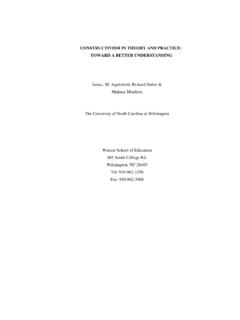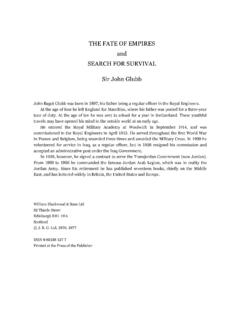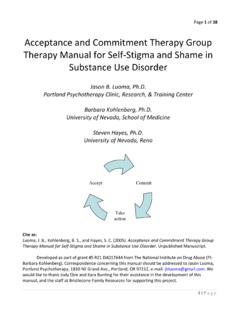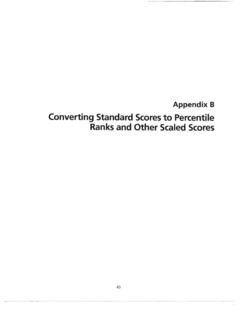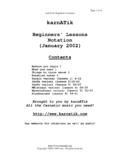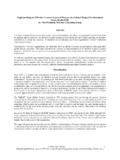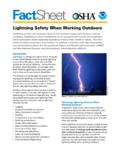Transcription of 100 Easy Lessons Revised - University of North Carolina at ...
1 teach your child to read in 100 easy LessonsCary AndrewsRoger Bacon AcademyWhat is 100 easy Lessons ? Supplemental Reading ProgramBdCR diPR diM tId II-Based on Core Reading Program: Reading Mastery I and IIPrincipal Author: Siegfried EngelmannScientifically-Based ProgramPrimary Purpose: Learning to read (Decoding)Systematic and Explicit Phonics ProgramRecord of success since the 1960 s. Project Follow-Through and National Reading Panel Utilized as ..- intervention program for struggling K-2 precocious preschool students- home school students Daily last on average 20-30 minutesidfihld i- scripted for precise teacher language and consistency- are highly teacher-directed- provide practice with sounds, words, and passagesMajor Instructional Tracks Sound Practice Sound Practice Oral Segmenting and Blending Oral Segmenting and BlendingWord Reading Word ReadingStdPRdi Sentence and Passage ReadingAdditional Instructional Tasks:Omit the following tasks: RhymingSdWiti Sound WritingUse these tasks as time permits: Story Reading: Parent Reads the Fast Way Story Reading: Word FindingTeaching Sounds in 100 easy Lessons Sounds are written in unique sound combinations are (lines over vowels) differentiate long/short ensure one-sound/symbol correspondence: No research utilized to determine initial sound taught.
2 Sounds are carefully sequenced to avoid and short o els as ell as conf sing so nds separatedLong and short vowels as well as confusing sounds separated. Program teaches two types of sounds:Continuous Sounds:can be held for three designated in script by three symbols: have a ball under them to remind of or Quick Sounds:are meant to be said quickly and quietlydare meant to be said quickly and designated in script by one symbol. dalways have an arrow under them to remind to release.>Delivery Elements for Instructional Tasks student attention to the attention is directed instr ctions are pro idedAfter attention is directed, instructions are provided. Wait three seconds for students to think of response. Cue and and students to prepare to students when to start and stop. the final student (Point to e.) Here s a new sound. I m goingtotouchunderthissoundandsaySounds Introduction1. Yo u re going to say all these sounds.
3 (Touch first ball for a.) Get ready. (Quickly move to the second ball. Hold.) Sounds Review: Slowlyto touch under this sound and saythe sound. (Touch first ball of arrow. Move quicklyto second ball. Hold.) u r turn to say the sound when under it. (Touch first ball.) Get ready. (Move quickly to secondball. Hold.) (Touch first ball.) Again. Get )2. (Touch first ball for s.) Get ready. (Quickly move to the second ball. Hold.) ssssssMove quickly to the second ball. Hold.) (Touch first ball for d.) Get ready. (Quicklymovetoendofarrow.)Focus:(Quickly move to end of arrow.) : _____Think: _____C/Si ldCue/Signal: _____Verification:_____>Sound Introduction and Review1. Yo u re going to say the sounds slowly,then you re going to say them fast. (Touchfirstballfors)SaythesoundslowlySou nds: Slowly and FastFocus: _____(Touch first ball for s.) Say the sound slowly. (Move quickly move to second ball.
4 Hold.) sssssss. Say it fast. (Move quickly to end of arrow.) : _____Cue/Signal: _____s2. (Touch first ball for a.) Say the sound slowly. ( )Verification:_____a(Movequickly move to second ball. Hold.) aaaaaa. Say it fast. (Move quickly to end of arrow.) (Touch first ball for d.) Get ready. (Quicklymovetoendofarrow.) Correction:My turn. (Quickly move to end of arrow.) it fast. (Move quickly to end of arrow.) u r turn. Get ready. (Signal )Ye sd>(Signal.) Ye s, over. Say the Sound: Slowly and Fast1. (Point to s.) Yo u re turn to touch the sounds and say them. First you re going to say this sound slowly and then say it fast. To u c h the child Touches the SoundFocus: _____Think:yyfirst ball of the arrow. Yo u re going to move to the next ball on the arrow and stop. When you stop, say the sound slowly. Do Now say it fast. : _____Cue/Signal: _____s2. To u c h the ball for the next sound.
5 Verification:_____aMove to the next ball and say the sound slowly. aaaaaa. Now say it fast. To u c h the ball for the next sound. Basic Correction:My turn. to the next ball and say the sound slowly. mmmmmm. Now say it fast. u r turn. Get ready. (Signal )Ye sm(Signal.) Ye s, over. child Touches the Sound1. (Touch under first ball of arrow.) Yo u re going to read this word. Yo u re going to sounditoutThenyou regoingtosayitfastWord Reading4. (Touch under first ball of arrow.) Yo u re going to read this word. Yo u re going to sound it out. Then you re going to say it fast. Sditt(T hddthsound it out. Then you re going to say it fast. 2. Sound it out. (Touch under r, a, and m as the child says rrraaammm without pausing between the sounds.)(Return to the first ball.)Sound it out.)
6 (Touch under s,e, and e as the child says ssseeeeee without pausing between the sounds.)(Return to the first ball.)Say it fast. (Slide quickly to end of arrow.) it fast. (Slide quickly to end of arrow.) s , what word? ram. Good : _____3. (Touch the a in eat.) This word has a little sound in it. We don t say thatsoundJustsaythebigsoundsy(qy)Ye s , what word? see. Good : _____Cue/Signal: _____that sound. Just say the big sounds. (Return to the ball.) Sound it out. (Touch under e, and t as the child says eeet without pausing between the sounds.)(Return to the first ball.)ramVerification:_____Say it fast. (Slide quickly to end of arrow.) s , what word? eat. Good a mEats E ESound it Out1. (Touch the balls for a and t.) First you re going to sound out this part. (Pointtoballfora)Getready(TouchballsforW ord Reading3. Now I m going to sound out cat.)
7 (Touch arrow under c.) (Point to ball for a.) Get ready. (Touch balls for a and t as child says aaat without pausing between sounds.) Say it fast. (Touch first ball for cat.)This word rhymes with at. What does it rhyme This arrow tells us that I can t stop under the sound. But the arrow tells us that you have to say the sound for the c. (Touch the first ball for cat.) ( with at. (Slide quickly to end of arrow.)cat. What word? cat. Ye s , My turn to sound out cat. (Slide past at ball for a. Continue to t and say:) Yo u r turn to sound it out. Get ready. (Slide past c. Stop at ball for a. Continue to t .) word? cat. catFocus: _____Think: _____c a tCue/Signal: _____Verification:>Verification:_____Fir st Sound Quick Sound1. Now you re going to read this word. (Touch the first ball for said.))
8 Sound it out. (TouchundersaianddastheWord Reading: Funny Words(Touch under s,a,i, and d as the child says:) s how we sound out the word. Here show we say the word. (pause.) do we say the word? (Return to the first ball.)Sound it out again. (Touch balls for sounds as child says:) say the word. said. Ye s , what word? said. saids a idFocus: _____Think: _____Cue/Signal: _____Verification:Verification:_____Funn y or Irregular Words1. Now you re going to read these words. (Touch first ball for ant.) Sound it out. (Touchballsforsounds )aaannntWord Reading3. (Touch first ball for fun.) Sound it out. (Touch balls for sounds.) fffuuunnn. What word? s , (R ttfi tbll)(Touch balls for sounds.) aaannnt. What word? s , (Return to first ball.) Yo u r going to read this word the fast way. But 4. (Return to first ball.) I m going to move down the arrow three times.)
9 Then you re going to read the wordthe fast way. (Move down the arrow three times stopping at first I m going to move down the arrow three times. Ta ke a good look at the sounds and see if you can remember this word. But don t say the sounds out loud until you read it the fast way. (Movedownthearrowthreetimesstoppingat(pp geach ball. Return to the first ball. ) read it the fast way. (Slide.) fun. Ye s , fun. Good (Move down the arrow three times stopping at each ball. Return to the first ball. ) read it the fast way. (Slide.) ant. Ye s , ant. Good n tfunFocus: _____Think: _____Cue/Signal: _____Verification:_____Transition to read Fast1. (Point to lots, have, his, near, and ears.) Word ReadinglotsYo u r going to read all of these word the fast way. I go down the arrow one time for each word. Figure out the word. But don t say anything out loud until I tell you to read it the fast way.))
10 2. (Touch the ball for lot. Touch under the sounds. Rbll)nEarReturn to ball.) read it the fast way. (Slide.) lots. Ye s , lots. 3. (Repeat step 2 for remaining words.)4. read all these words again the fast (Touch first ball for lots. Pause three seconds.) read it the fast way. (Slide.) lots. Ye s , lots. 6. (Repeat step 5 for remaining words.)EarsgOatsFocus:gOatsBasic Correction:Focus: _____Think: _____C/Si lMy turn. u r turn. Get ready. (Signal.) Ye s , it out. Get ready. (Signal.) Cue/Signal: _____Verification:_____y(g )What word? (Signal.) Ye s , the Fast Way 1. (Touch ball for ar.) Word ReadingarWhen these letters are together they are. What do they say? (Touch the ball for ar in far.)What do these sounds say? are. Ye s , are. (Touch the ball for far.) Sound it out. (Touch balls for sounds.) fffarararRdihf(Slid)ffarRead it the fast way. (Slide.
